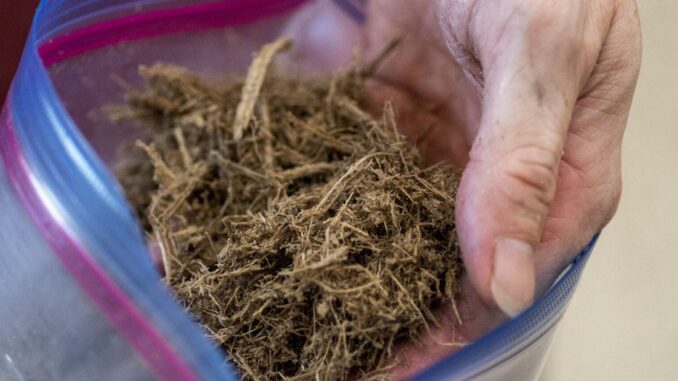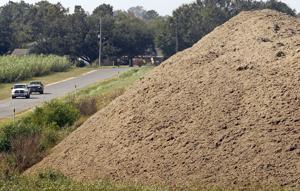
Sugarcane is thriving in Louisiana. The state’s sugarcane fields produced a record 9.4 million tons of raw sugar during the 2021-2022 harvest season, and despite a rare freeze this year’s crop was on track to beat that record in January.
But more sugarcane means more bagasse, a material researchers are trying to find new uses for as it accumulates, taking up acres and forming mulch mountains.
What is bagasse?
Bagasse is the waste that remains after sugarcane stalks are pressed to extract their juice. It’s dry and pulpy, light and fluffy, and currently piling up around Louisiana.
Where does it come from?
A bulldozer mover bagasse around as piles added up from the local sugar cane farmers at American Biocarbon at the Cora Texas Sugar Mill on Thursday, May 18, 2023 1in White Castle, Louisiana.
Bagasse comes from sugarcane stalks. After sugarcane is harvested, the stalks are taken to a refinery to extract the sugar inside. The stalks are washed, crushed, and the sugary juice is separated from the plant material, or bagasse.
Mills then burn the bagasse as fuel to power the refinery.
“Mills use very little fossil fuel inside the factory. So when all that juice gets extracted out of the pulp, the majority of the bagasse ends up going to the boilers,” said Kenneth Gravois, sugarcane specialist at LSU’s Sugar Research Station.
About 10% is typically not usable and gets stacked into piles.
What does it look like?

Brad Gulotta holds a handful of the sorted non dried bagasse that will be made into pellets in the American Biocarbon quality testing lab at the the Cora Texas Sugar Mill on Thursday, May 18, 2023 in White Castle, Louisiana. Bagasse is sorted and dried for the various products that the plant produces with no part of the bagasse going to waste.
Bagasse looks like hay, dried tree bark, or shredded cardboard. It’s very light and fibrous.
What normally happens to it?

American Biocarbon uses a large rolling dryer to dry the bagasse at the Cora Texas Sugar Mill on Thursday, May 18, 2023 in White Castle, Louisiana. The dryers are started using natural gas then are switched over to using heat from the process to finish drying for limited environmental impact.
By far, the biggest use for bagasse is burning it in sugarcane mills as a green fuel. All 11 sugar mills in Louisiana have used bagasse as fuel for years.
“We are in essence biorefineries. We grow our own energy,” said Jim Simon, manager of the American Sugar Cane League.
Once juice is extracted from the cane, the bagasse goes into boilers, which create steam that powers moving equipment and electricity generators.
What are some alternatives uses for it?
Hundreds of millions of dollars have been spent trying to find alternative uses for bagasse.

Josh Molliere, of American Biocarbon, holds finished absorption pellets at the Cora Texas Sugar Mill on Thursday, May 18, 2023 in White Castle, Louisiana. American Biocarbon produces several different bagasse pellets from biofuel to absorption.
One use gaining traction recently is fuel pellets, a coal alternative used in industrial heating plants that are transitioning away from fossil fuels.

Brad Gulotta holds a handful of biochar which is one of the products made from bagasse in the American Biocarbon testing lab at the Cora Texas Sugar Mill on Thursday, May 18, 2023 in White Castle, Louisiana. Biochar is made from the leftover bagasse that is not top quality so there is no waste at the plant.
American BioCarbon, which runs a fuel pellet plant on the Cora Texas mill property in White Castle, also makes biochar. Biochar is placed underground to absorb water and fertilizer, which sugarcane roots can draw from during a drought.
Another potential for bagasse could be biomass slurry injection. A group of LSU professors has been researching how to take bagasse, grind it into a slurry, and inject it deep into the ground.
Other researchers are looking into creating second-generation ethanol, and some companies in Florida and Australia make paper plates and food storage containers out of bagasse.
Gardeners across the country say they could benefit from bagasse as a soil fertilizer.
“As an upper Midwest gardener, my eyes lit up at the thought of being able to have a garden and landscape with bagasse mulch. Up here we’d put it to good use!” said Merrily Satterstrom.
Unfortunately, it’s a pain to move.
“There’s just so much of it and it’s just so fluffy and light,” said Gravois. “Transporting it long distance is not cost effective.”

A loader adds processed bagasse into a hopper for the machine that makes the finished pellets at American Biocarbon at the Cora Texas Sugar Mill on Thursday, May 18, 2023 in White Castle, Louisiana.
He and others hope more uses come to market soon, as it also costs money to keep and maintain bagasse in piles, not to mention they sit on land that could be used to grow more sugarcane.
“If I had a nickel for every time I’ve sent a sample of bagasse,” said Alan Chatman, general manager at Alma Plantation. “No one’s cracked the code quite yet, but we wish that someone would figure out a way to commercialize all this surplus material.”


Leave a Reply